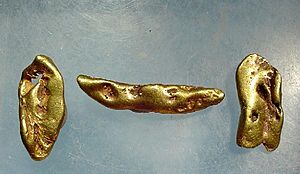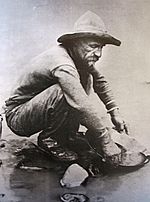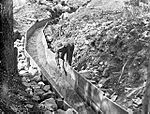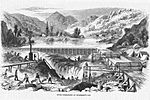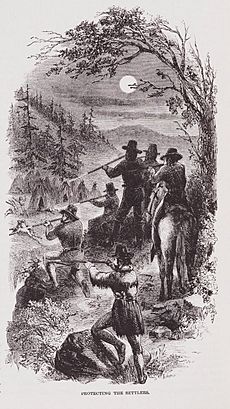California Gold Rush facts for kids
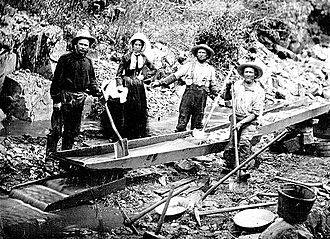
Gold seekers working in California in 1850
|
|
| Date | January 24, 1848–1855 |
|---|---|
| Location | Sierra Nevada and Northern California goldfields |
| Participants | 300,000 prospectors |
| Outcome | California becomes a U.S. state and California genocide |
The California Gold Rush was a time from 1848 to 1855. It was a period in American history when many people from all over the world became very interested in gold. This happened after gold was found in the Sierra Nevada mountains of Central California and later in Northern California.
Contents
Gold in California
There was a lot of gold in California. This happened over hundreds of millions of years! Volcanoes, moving land plates, and erosion all worked together. They helped to gather billions of dollars' worth of gold in the mountains of California. Sometimes, people found "fool's gold" (pyrite), but experienced gold miners could tell the difference.
History of the Gold Rush
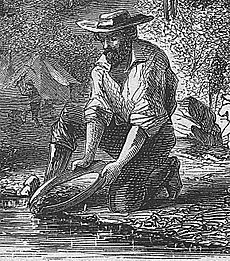
The gold rush started on January 24, 1848. A man named James W. Marshall found gold at Sutter's Mill in Coloma, California. When news of the gold spread, about 300,000 people came to California. They came from other parts of the United States and from other countries.
The first people to arrive from outside California came from Oregon, Hawaii, and Latin America in late 1848. About half of the 300,000 people came by sea. The other half traveled overland on trails like the California Trail. Many of these "forty-niners" (named after 1849, a busy year) faced tough journeys.
Even though many new arrivals were Americans, thousands also came from Latin America, Europe, Australia, and China. Farms and ranches grew quickly to feed all the new people. By 1854, over 300,000 immigrants had arrived.
San Francisco was a tiny town of about 200 people in 1846. By 1852, it had grown into a busy city of about 36,000 people! New roads, churches, schools, and towns were built all over California.
In 1849, people in California wrote a state constitution. This new plan for government was approved by a vote. In September 1850, California officially became a state.
At the start of the Gold Rush, there were no clear rules about who owned what land in the goldfields. So, miners created their own system of "staking claims." Early gold seekers found gold in streams and riverbeds. They used simple tools like pans. Even though this mining hurt the environment, new and better ways to find gold were invented. These methods were later used around the world.
New ways to travel also appeared. Steamships started regular trips. By 1869, railroads connected California to the eastern United States. As mining became more advanced, it needed a lot of money. This meant that large gold companies became more common than individual miners.
Gold worth tens of billions of dollars today was found. A few people became very rich. However, many who joined the California Gold Rush ended up with little more than they started with.
How Gold Was Recovered
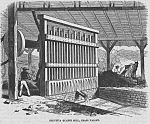
At first, the gold in California's rivers and streams was easy to find. The early "Forty-Niners" simply panned for gold. But panning couldn't be done on a large scale. So, clever miners started using "cradles," "rockers," and "long-toms." These tools helped them process much larger amounts of gravel. Experts believe that about 12 million ounces of gold were found in the first five years of the Gold Rush. That's worth about US$8.5 billion today!
Later, by 1853, a new method called hydraulic mining was used. This was for older gold-filled gravel beds on hillsides. In hydraulic mining, a powerful stream of water from a high-pressure hose is aimed at the gravel. This loosens the gravel and gold. The mix then flows over sluices, where the heavy gold settles at the bottom. By the mid-1880s, about 11 million ounces of gold had been found this way.
The last way to find loose gold was to look for it in the flat river bottoms and sandbars. Over millions of years, gold had washed down into areas like California's Central Valley.
By the late 1890s, dredging technology became useful. This method was also invented in California. It's thought that over 20 million ounces of gold were found by dredging. That's worth about US$14 billion today!
Miners also did "hard-rock mining." This meant digging directly into rocks, usually quartz, to find gold veins. They would blast and dig to follow these veins. Once the gold-filled rocks were brought up, they were crushed. Then, the gold was taken out, often using chemicals like arsenic or mercury. Over time, hard-rock mining became the biggest source of gold from the main gold areas.
Where the Gold Went

Much of the gold found was used right there in California. Miners used it to buy food, supplies, and places to stay. They also spent it on entertainment. These payments were often made with the freshly dug gold, carefully weighed. The shopkeepers and sellers then used this gold to buy more supplies from ship captains or traders.
A lot of the gold also left California. It traveled on ships or by mules to other parts of the world. It went to the people who made the goods that California needed. Many miners also returned home, taking their hard-earned gold with them.
Impact of the Gold Rush
The sudden rush of gold into the money supply helped the American economy grow stronger. The huge increase in people also helped California quickly become a state in 1850.
By the time the Gold Rush ended, California had changed a lot. It went from being a lightly populated area that used to belong to Mexico. It even had one of its first U.S. Senators, John C. Frémont, chosen to be the first presidential candidate for the new Republican Party in 1856.
Sadly, the Gold Rush had a very negative impact on Native Americans. They relied on hunting, gathering, and farming. But the mining operations put gravel, dirt, and harmful chemicals into the rivers. This killed fish and destroyed their homes. Also, as more miners arrived, their camps and towns took over land. This meant less game and food for Native Americans. Later, farms spread to feed the settlers, taking even more land.
Whole groups of Native Americans were attacked and forced off their lands by the gold-seekers.
California's name became forever linked to the Gold Rush. The idea of finding quick success in a new place became known as the "California Dream."
Interesting Facts About the California Gold Rush
- The Gold Rush greatly affected industrial and agricultural growth.
- It helped California's economy grow fast, which led to California becoming a state quickly.
- Most of the people actively involved in the Gold Rush were men.
- It's thought that about US$80 million worth of California gold (which is billions today) was sent to France by French gold seekers and traders.
- There is still gold to be found in California today!
- The California Gold Rush was not the first gold rush in America. The first one happened 50 years earlier in Cabarrus County, North Carolina.
Images for kids
-
California goldfields (red) in the Sierra Nevada and northern California
-
1855 illustration of James W. Marshall, who found gold at Sutter's Mill
-
Portsmouth Square, San Francisco, during the Gold Rush, 1851
-
Crushing quartz ore before washing out gold
See also
 In Spanish: Fiebre del oro de California para niños
In Spanish: Fiebre del oro de California para niños


